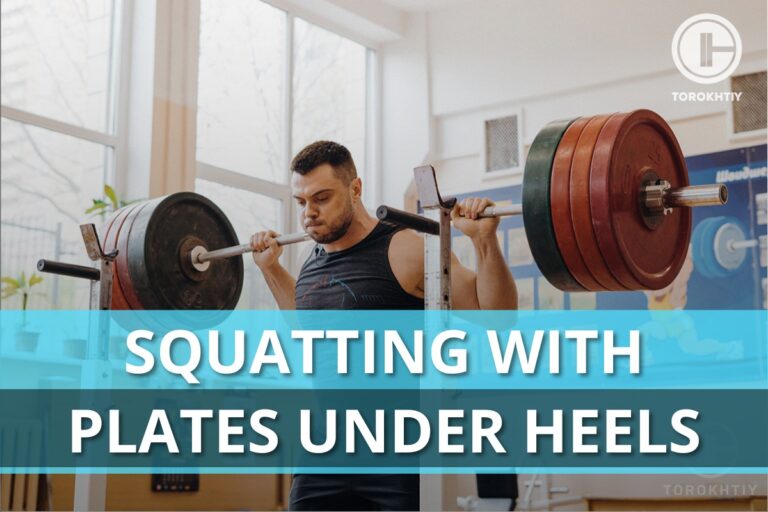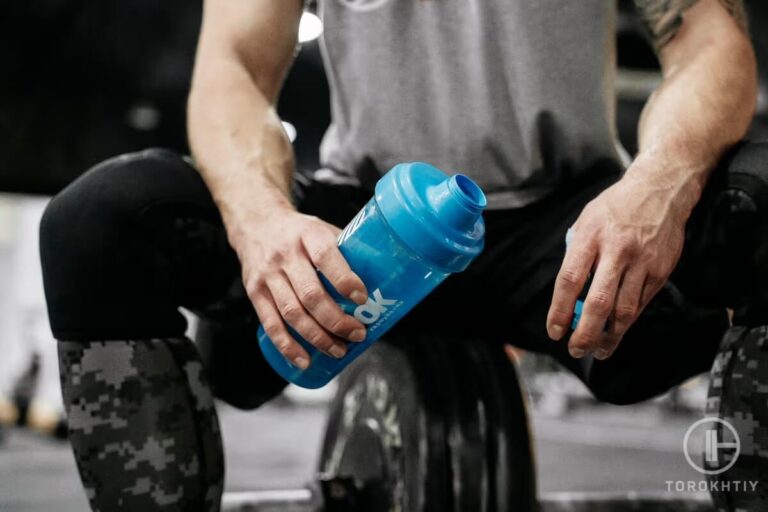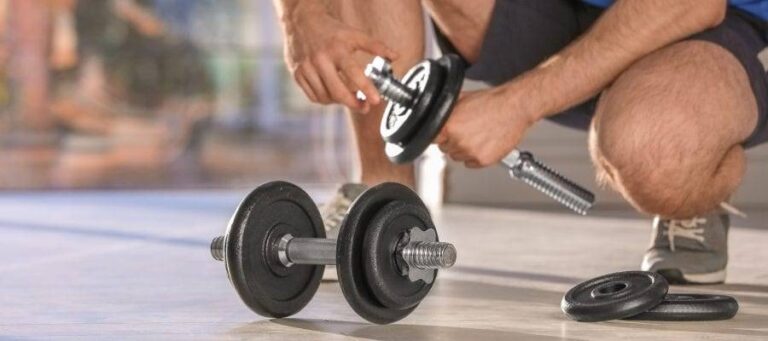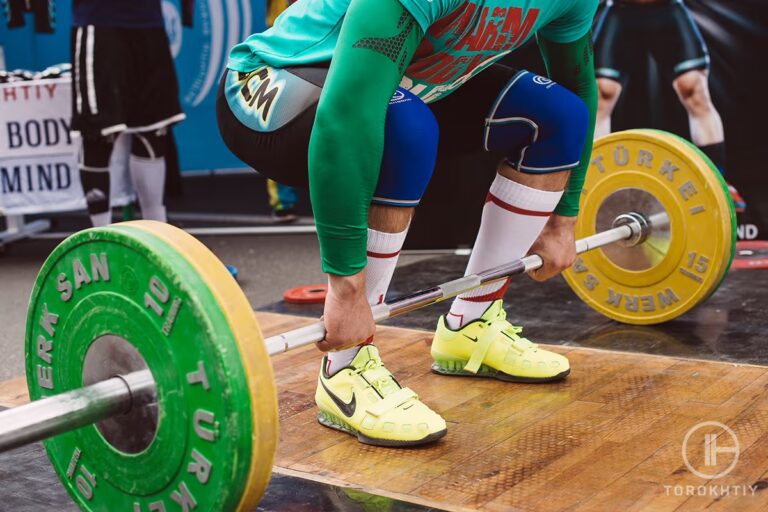Effective Strongman Training Program to Gain Max Strength: Things You Should Know
Trying to get into your first strongman competition, or do you just want to pump up like a true strongman? Or looking to break through a training plateau avoiding injuries and still make significant progress? Strap into the efficient strongman training program that will set you up for new heights in strength workouts. You’ll find a proper approach that will reflect your training goals.
Strongman training program consists of deadlifts, overhead presses, carrying, moving, loading, pulling, and pushing events. It aims to improve overall strength and technique to participate in competitions and also perform major exercises better. Better to work out the entire body, as well as enhancing cardiovascular conditioning and grip strength.
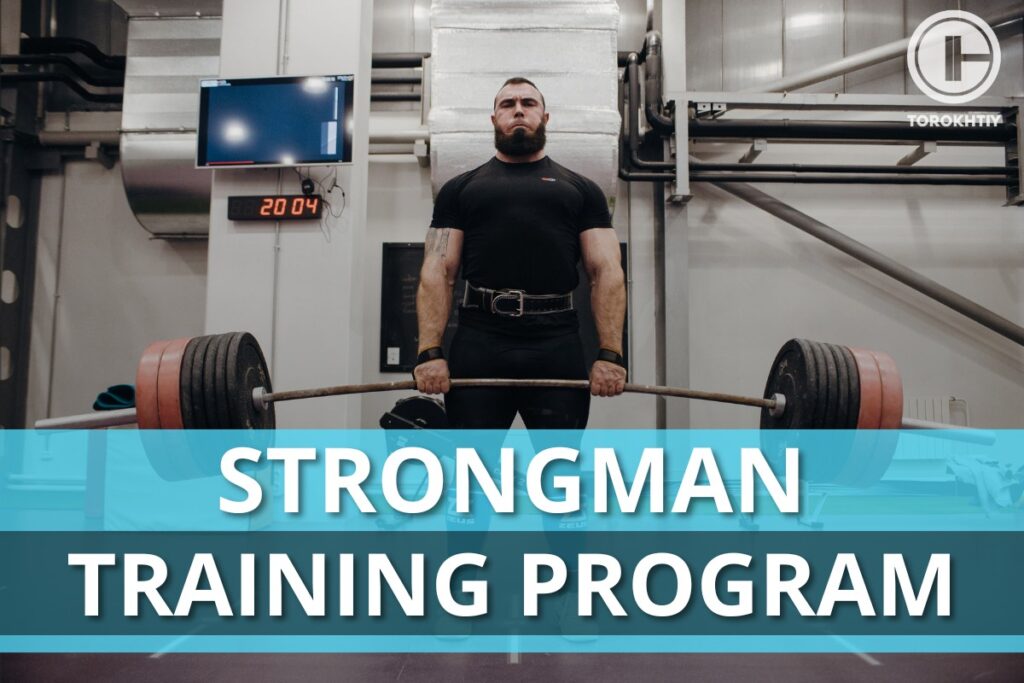
Main Strongman Program Objective
To start with, Strongman is a kind of strength sport where athletes should deal with various challenges of extreme strength. Considering the biomechanics, Strongman exercises are generally heavier versions of common everyday activities.
While another study stated the viewpoint that Strongman training can be effective at causing similar acute physiological responses to those of traditional strength exercise training.
Similar metabolic adaptations were observed during Strongman training and traditional strength exercise training, while both can cause cardiovascular adaptations in addition to the expected metabolic adaptations commonly associated with resistance training.
Strongman training and traditional strength exercise training can be used to increase energy expenditure and, in turn, the energy deficit necessary for weight loss.
To cope with such kind of physical exertion, an athlete should have an overall background in strength & fitness training to cope with greater physical activities. As usual, the strongman workouts incorporate training with odd objects like pulling trucks, carrying sandbags, deadlifting, and pushing pressing logs of different shapes.
Strongman competitions are not just about lifting extreme weights. It also involves explosive and endurance-efficient movements. There are standard exercises for athletes to perform: deadlifts, overhead presses, carrying and moving exercises, also loading, pulling, and pushing events.
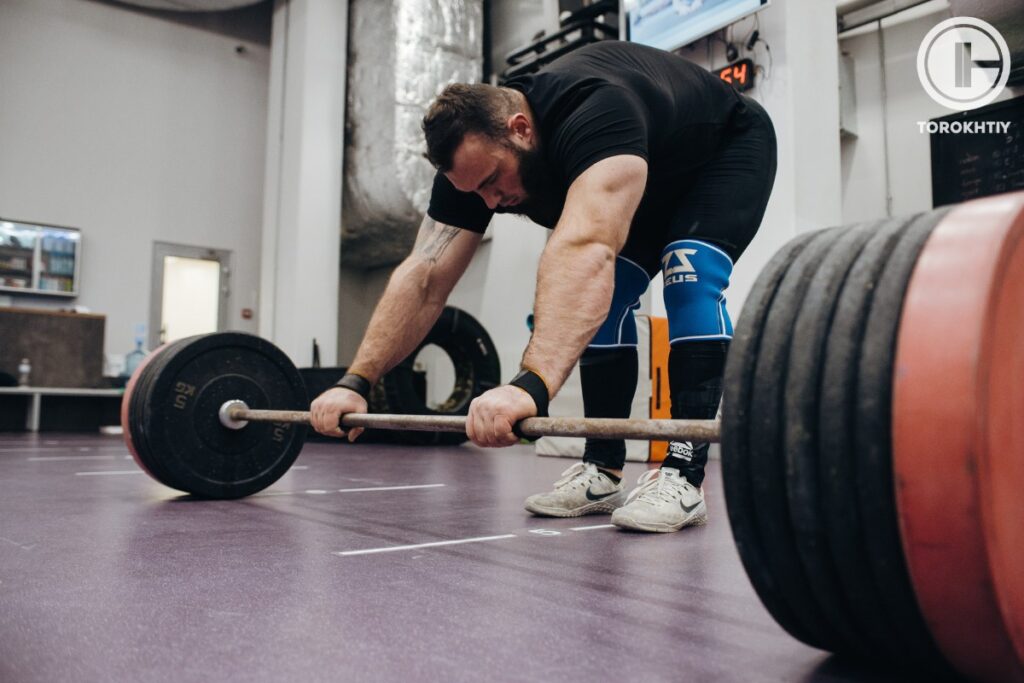
The main goal
Strongman workout is a real strength-oriented feat, which can become handy for those who are searching for new experiences in their workouts, or who want to become stronger and more endurant.
The strongman training program builds up brute raw strength and tests an athlete’s sports resilience and determination. Overall, Strongman competitions are versatile and this is the biggest advantage: everyone can take up strongman training or incorporate some movements into their training program, no matter the age and fitness level.
The research proved the efficacy of a strongman training program, which occured to be as effective as traditional resistance training program in improving body composition, muscular function, and performance.
Development of qualities
A thoroughly built-up strongman workout plan will bring lots of benefits to your condition and performance. However, the key point is planning how much load to use in the particular exercise. As it has a functional nature, pretty everyone can add strongman lifts into their training routine.
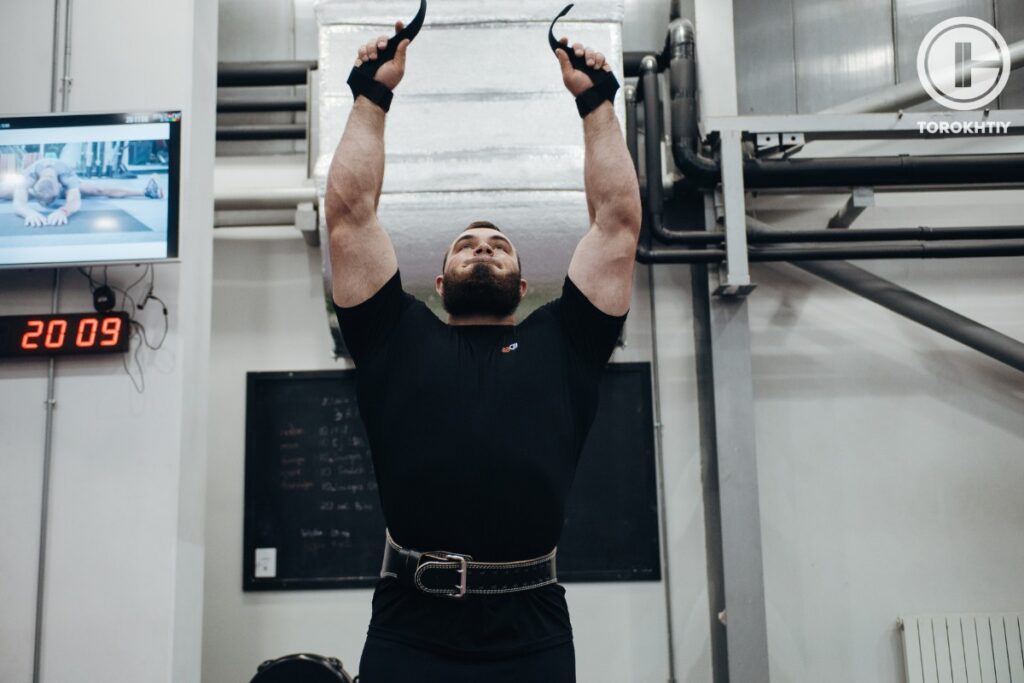
1. Improving Functional Strength
Functional strength in the strongman training program is about moving heavy odd items as if you’re doing it every day. This includes picking up, carrying, pulling, pushing, and throwing the load with the help of your strength. Strongman workout is a sport that can boost your strength to achieve new athletic gains.
2. Overcoming Training Plateaus
Over time each of us gets used to the same stimulus that repeats each training, without any progress and new movements to challenge our body. To fix it, Strongman training is exactly a new stimulus that can lead to your progress. As your body is not familiar with such kind of physical exertion, that will force your body to adapt to new workout levels.
3. Boosting Muscle Mass and Bone Density
Since most strongman exercises are performed with high rep ranges and make you feel great tension, you’ll succeed in building solid muscle mass. Consequently, as your muscle tissue grows, you’ll boost your bone density as well.
4. Improving Core and Grip Strength
While you’re moving heavy objects, the stabilizing muscles of your core keep your spine straight. So, you develop core stability. Speaking about grip strength development, strongmen always perform carrying and holding movements of different things of any shape. It may include various grip options – open-hand, pinch, and fat grip – which help to develop excellent grip strength.
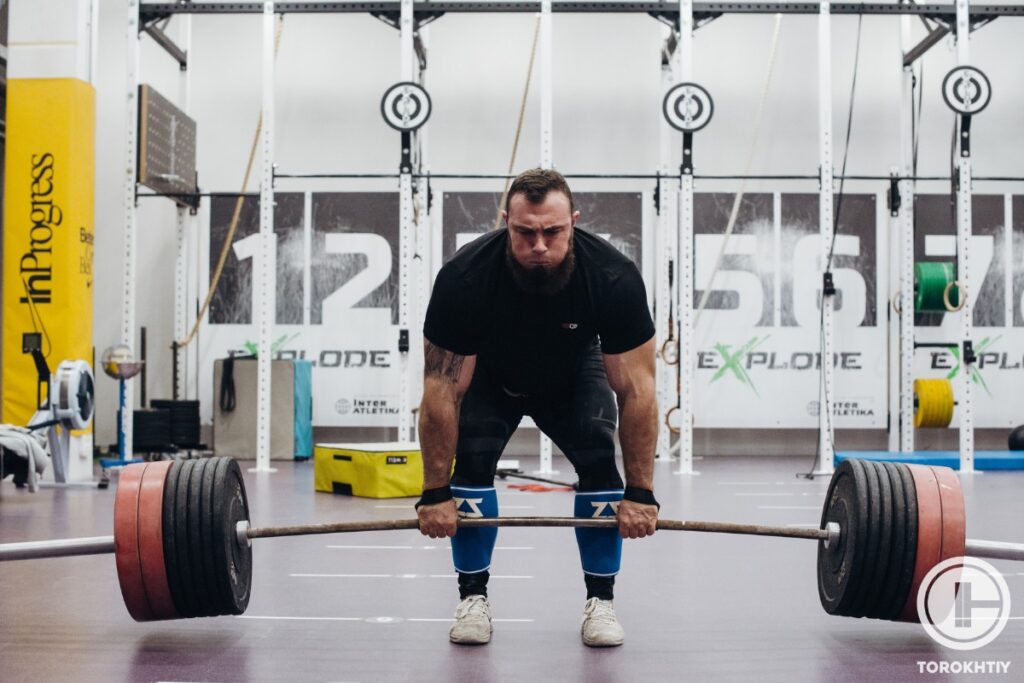
5. Improving Cardiovascular Health
Doing multiple reps within the defined time really makes your heart rate go up. Apparently, all strongman exercises will help you to develop your heart well.
Strongman Program Composition
A key to success in arranging an efficient strongman programming lies in the proper training regime that includes a stable training schedule, performing strongman workouts correctly, proper mindset, dedication, and also having enough time for recovery.
To build up an effective strongman workout routine, you need to define your weak points and work on them first, then skill up your mastery. You need to select exercises that will correct your technique and facilitate strength form, for instance, incorporating dumbbell swings, Farmer’s walk, sled drags, thick bar lat-pulldowns, safety bar squats, etc.
Loads and Number of Workouts
It’s recommended to train more than 2 days in a row and then have a rest day. Strongman is a kind of strength sport that requires adequate recovery in between workout sessions.
Keep in mind the following fact: what you do in the gym has a direct impact on your competition performance. The Strongman programming means being strong, explosive, and endurant to withstand multiple reps and distance.
However, many newbies spend too much time working out with light weights and isolating muscle groups. Meanwhile, strongman training involves the entire body, requiring coordination of inner focus and muscles to control the body. It promotes massive muscle growth all over the body as a response to the extreme stimulation of the whole body.
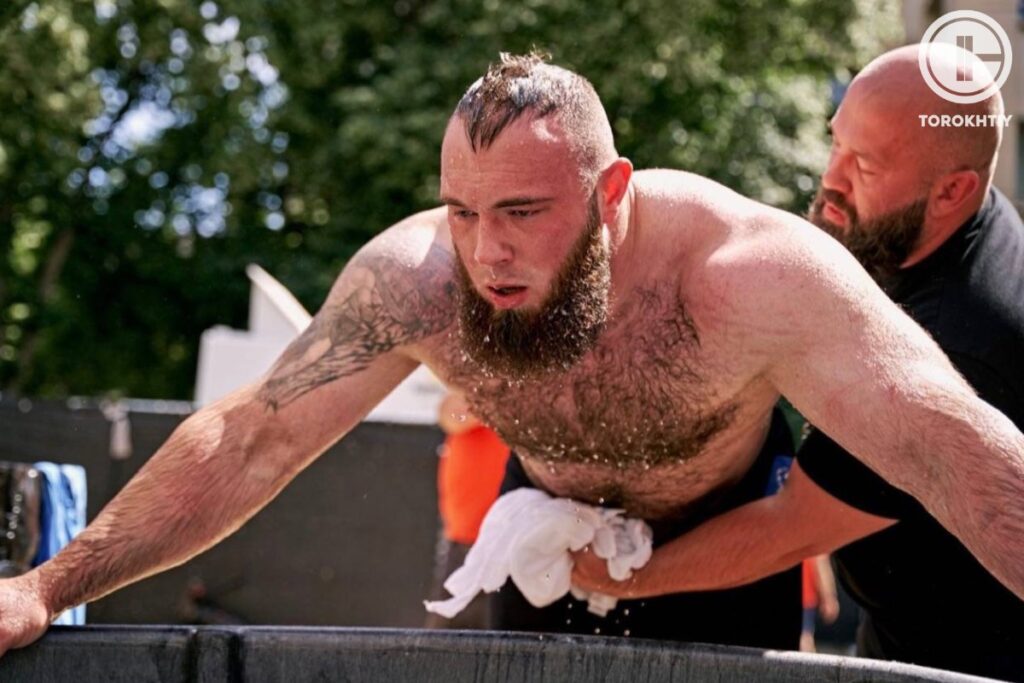
2 weeks of training
As usual, some strongmen can separate each muscle group to work out with, i.e., a strongman training split, or combine different muscle groups in one training to get full-body training at a time.
For instance, the first week can be divided according to the following system:
- Lower body training (including back squats, heavy goblet squats, dumbbell walking lunges, Zercher squats).
- Shoulders and chest (bench press, overhead tricep extension, single arm clean and press, etc).
- Back and posterior chain (deadlift, dumbbell rows, seated rows, lat pulldown).
One day can be dedicated specifically to Strongman competition training that can include practicing the following exercises: throwing Atlas stones or sandbags, Farmer’s walk, log press, sled pushes and pulls, etc.
Another day can be dedicated to cardio exercises to pump up the cardiovascular system. Besides a vigorous workout routine, don’t forget to arrange one or two rest days in a week.
1 week of rest
Usually, athletes take 1-2 days off every week, with a full week off for every three months. For some strongmen athletes, conditioning exercises help to recover quicker after intensive drills.
A perfect option is incorporating a short cardio workout, which provides an interval load. It’s recommended to perform several sets with a duration of 20-40 seconds of 130-170 HR, then resting for 2-4 minutes at 110 HR between sets. Another variant is doing acceleration sprints on the airbike, or rowing machine, or sled pulls for 2-4 minutes.
Also, a strongman can perform long low-intensity cardio sessions, meaning cycling or rapid walking for 30-60 minutes at 110-130 HR. Such workouts may positively influence athletes’ cardiovascular endurance.
A reload week will be enough time to cope with fatigue and continue making progress. However, it is not enough for adequate recovery time for the connective tissues. Having at least two months every year to work with lighter weights will improve an athlete’s longevity in the sport.
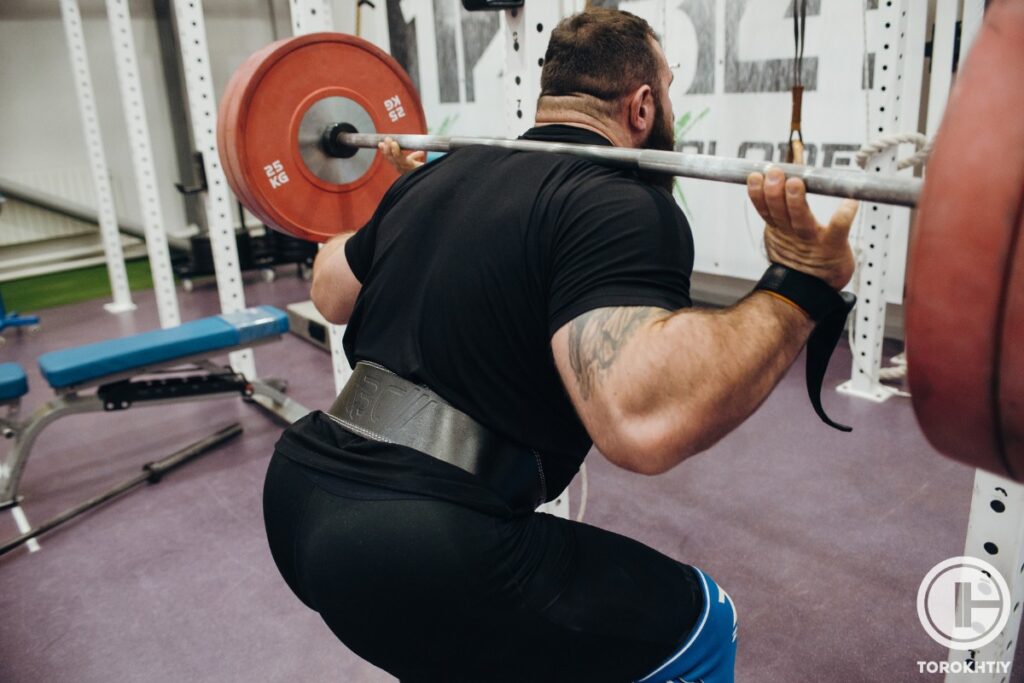
4-5 cycles
Several weeks can be dedicated to hypertrophy and strength endurance development via aerobic loads. During this period you will lift several days in a row a week, with 30 minutes of aerobic workout in the morning. Let’s start with hypertrophy: this is one of the major ways to increase strength due to the development of muscle mass. The hypertrophy training may include 8 sets on each working muscle group for 6-12 reps.
Another option is doing aerobic work on two or three of the days that are out of lifting training. It can be walking, jogging, cycling, or swimming sessions. It’s important for working out strength endurance in the form of aerobic load. The goal is to increase mitochondria amount and its power in order to prolong the period of training under the load to boost strength endurance.
It can be an interval cardio with the load for 10-40 seconds at 170-180 HR with 2-4 minutes of rest at 110 HR. Such a training set can be performed 1-2 times a week to facilitate the general power of mitochondria cells. As well as a long low-intensity cardio workout at 110-130 HR.
For the aerobic workout, it’s recommended to start around 65% of heart rate (HR) max for 30 minutes and work up to 70-75% of HR max by the end of the block. Most people would be better off taking advantage of three full rest days each week to recover from the increasing volume of the hypertrophy work. It needs to be mentioned that hypertrophy may occur in the case of energy proficit.
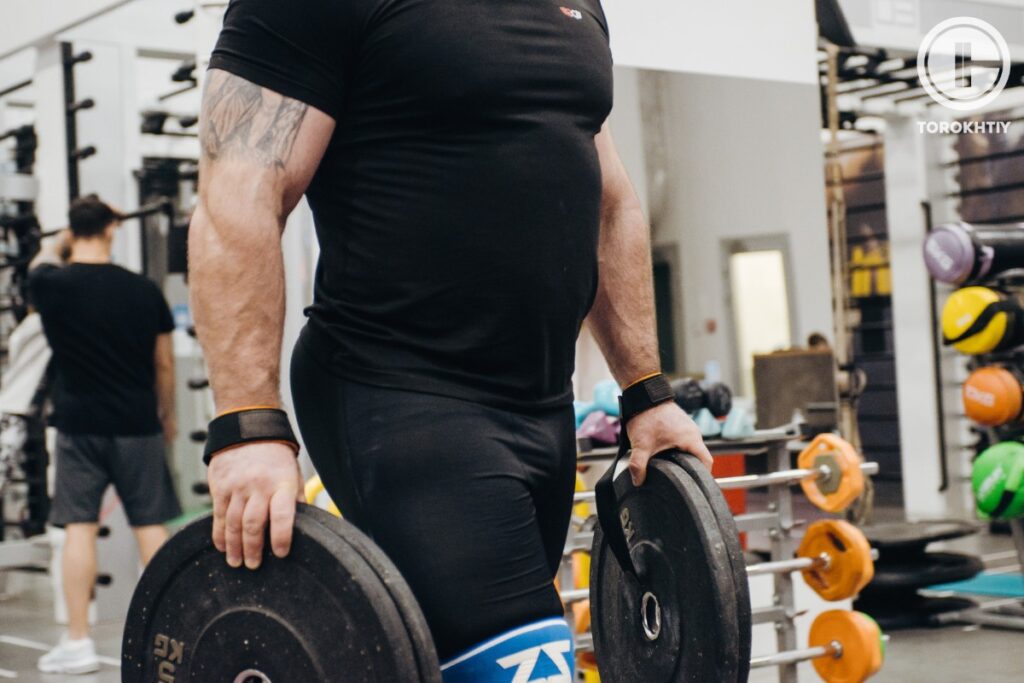
Result checks
Tracking results provides a clear picture of what is going on for the moment and what weak points should be worked out next for you to become stronger. With proper track of your results, you’ll succeed in reaching your goals and even surpass your expectations, becoming more efficient in your time and workout effectiveness.
Checking the results of the strongman workouts allows for easier modification of training sessions and shows where changes need to be made. It also helps to focus and stay committed to your training program.
| Week 1 | Week 2 | |
|---|---|---|
| Day 1 | Lower body training: -back squats -Zercher squats -dumbbell squats -dumbbell walking lunges | Aerobic training: jogging, running, cycling, or swimming sessions. Start at 65% of HR max for 30 minutes and work up to 70-75% of HR max |
| Day 2 | Shoulder & chest training: -bench press -overhead tricep extension -single arm clean and press | Hypertrophy training: -Bench press – 4 sets of 6-8 reps. -Pull-ups – 4 sets of 6-8 reps. -Dumbbell curls – 3 sets of 8-10 reps. -Seated calf raises – 3 sets of 8-10 reps. -Romanian deadlifts – 3 sets of 8-10 reps -Barbell bicep curls – 3 sets of 8-10 reps. |
| Day 3 | Rest day | Rest day |
| Day 4 | Back & posterior chain training: -deadlift -dumbbell rows -seated rows -lat pulldown | Lower body training: -front squats – 2 sets of 8 reps (70% of your 1 RM) -paused back squats – 3 sets of 3 reps with 3 secs pause -glute ham raises – 4 sets of 10 reps |
| Day 5 | Strongman competition training | Bodybuilding training (4 sets of 6 reps): -back squats -incline dumbbells chest press -power shrugs -one-hand dumbbell snatch |
| Day 6 | Cardio training | Conditioning exercises: rowing, airbike, cycling, skiing, battle ropes |
| Day 7 | Rest day | Rest day |
Basic Strongman Workout
Indeed, Strongman exercises demand not only brute strength and stamina, but also superb balance, core stability, exemplary secure grip, and even iron lungs to cope with excessive tension while dealing with insane weights. Let’s observe how to train for a strongman tournament by reviewing a step-by-step plan starting from the warm-up session and mentioning major strongman movements.
1. Warm-up
There’s one crucial point you should keep in mind before taking up a strongman-style training program. Heavy lifts put great stress on the body and if you train too often, or have poor technique, you are likely to get injured. To reduce injury susceptibility don’t forget to warm up properly before the workout.
For fruitful strongman workouts, it’s important to activate the glutes as they are key players in squat and deadlift movements. You can do glute bridges, raising the hips until the glutes are fully engaged. Then do knee out movement to activate the hip abductors before squatting and prevent the knees from caving inward.
The next step is to activate the core by performing a dead bug exercise and plank. The last step is to mobilize the hips and knees. Additionally, it’s possible to do dynamic stretching, foam rolling, myofascial release work, or static stretching to prepare the body for great loads.
2. Specialized strongman exercises
To master Strongman exercises, you need strong functional and practical strength, excellent core stability, endurance, and raw power.
Here are several essential Strongman exercises that you can include in your training regime: throwing Atlas stones, Conan’s wheel, deadlift, duck walk, dumbbell press, farmer’s carry, and so on. The main goal is to develop static strength, work capacity under the loads, core and upper back thickness, movement explosiveness, and grip strength.
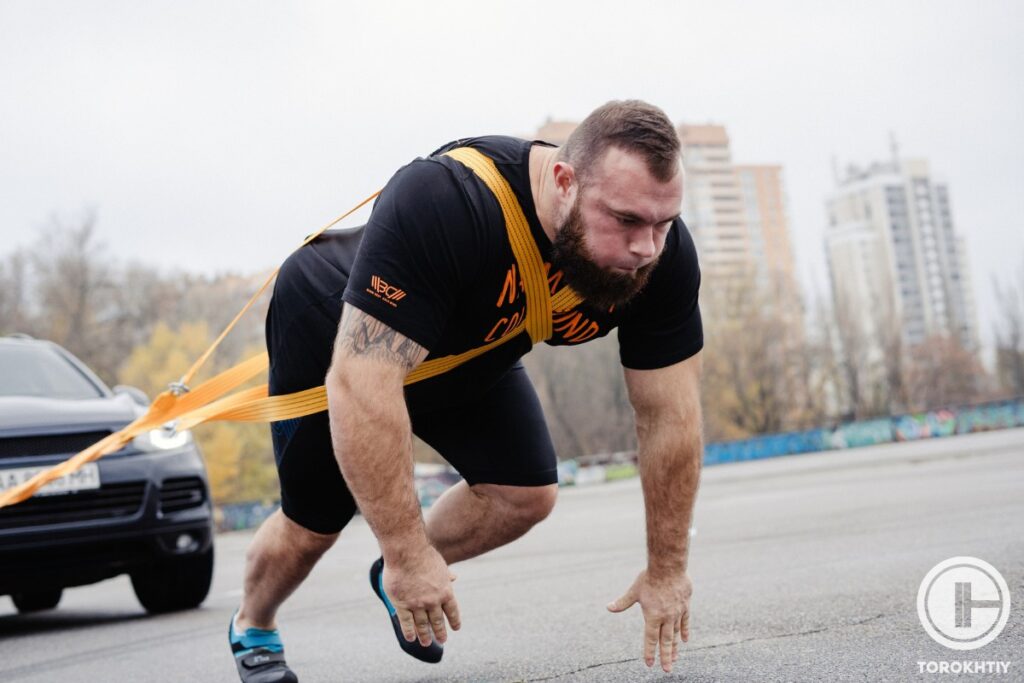
3. Additional exercises
Additional exercises include squat variations, rows, deadlifts, lat pull-downs, and overhead presses that can help you train for your goals. The key point is to develop the body adaptation necessary to withstand the stress of any grade.
Improved core strength, proprioception, and power are examples of physical reactions to progressive overload. The heavier weights will help support you at the basic level in Strongman competitions.
4 Main Strongman Exercises
Generally, a Strongman session fits everyone: no need to hesitate whether you’re not strong enough for such tension and extreme weights. This strength training is perfect for building up power and increasing muscles for all-level athletes. So, you can withstand much more than you think – just pick up a strongman workout program for your workout plan.
Strongman movements will make you extremely strong, no matter if you’re a newbie in weightlifting or a seasoned athlete who trains hard. You can find numerous strongman exercises you can incorporate into your training routine. However, the choice will depend on your goals and movement, and physique competency. So, stop doubting and practice those movements to excel in the competitions.
Overal, Strongman events challenge the body strength, together with the stabilizing system, in a different way than traditional approaches. The carrying events challenge different abilities than the lifting events, suggesting that loaded carrying enhances traditional lifting-based strength programs.
The study indicated that strongman competitors can experience specific injuries, mainly the back ones. Muscle electromyographic data from various torso and hip muscles, together with kinematic measures, were input to an anatomically detailed model of the torso to estimate the level of back load, low-back stiffness, and hip torque.
1. Super yoke
The super yoke carry is a common exercise in a Strongman competition. It includes lifting and carrying a heavy yoke frame along a particular distance or period. The yoke consists of a horizontal crossbar you put on the upper back, and two upright posts you can upload with weight plates. This exercise develops your lower body and core strength. Also, you’ll notice the improvement in your static lifts due to the ability to brace the core while performing this exercise.
Speaking about the biomechanics of the super yoke walk, during the exercise, the abdominal and thigh muscles reached peak activation during the walk or first step phases. Peak activation of the thoracic and lumbar erector spinae muscles occurred during the lifting and lowering phases of the movement.
2. Farmer’s walk
The Farmer’s walk or Farmer’s carries exercise is a perfect option to build up phenomenal strength. All you need is two items ideally with handles of equal weight. It’s possible to use a trap or hex bar or farmers carry handles you can load with plates.
To do this movement, you need to do a sort of squat-hinge to grip the handles, then inhale to brace your core. Keep your back tight and press into the floor as you stand up with the weights. Then just walk forward, keeping your spine neutral, shoulders even, and gaze towards the horizon.
According to the research, peak activation of the abdominals and RRF (right rectus femoris) muscle occurred during the walking phase; however, peak activation of the latissimus dorsi, thoracic, and lumbar erector spinae muscles occurred during the lifting phase of the event.
3. Deadlift
This is a conventional exercise of a strongman program for total-body strength. By doing it, you activate the following muscle groups: hamstrings, quads, glutes, hip flexors, lower back, abdominals, shoulders, and arms. This movement is also suitable for improving core and grip strength, and overall athletic development.
Generally, a deadlift is a solid foundational movement for scaling up your endurance and getting ready for a basic strongman workout. It’s a great option to start your strongman workout journey. This exercise works well for your whole body, especially your posterior chain: glutes, hamstrings, and lower back.
4. Log lift
Whether you’re planning to compete in a Strongman event, or just want to incorporate another strength-building movement into your workout routine, the log pressing/ lifting will meet your expectations.
Being a hardcore exercise, this exercise will help you to build not just full-body strength, but also will put your shoulders in a stable position. It’s believed to be a sort of more accessible form of overhead pressing than barbell pressing for those with shoulder issues.
The log press may be an option for an overhead press, which will challenge your shoulders, triceps, lats, traps, and core, and even promote your leg strength greatly.
Additional Strongman Exercises
Seems that it’s time for you to start incorporating some strongman exercises into your training routine, doesn’t it? We’ll help you to fill the gaps in your workout program of functional strength, grip, and conditioning training.
Besides the key Strongman events, there are additional accessory movements that are equally useful for developing functional strength, cardiovascular conditioning, and speed. Still, you’ll succeed in building raw muscle mass.
1. Squat with barbell
Squatting is one of the most efficient ways to strengthen your lower body, namely in glutes, quads, and upper back. It’s a fundamental movement that is essential for performing other strongman events without hassle.
There are lots of squat variations you can choose from: back squat, front squat, safety bar squat, belt squat, etc. You can also choose other accessory squat exercises such as powerful powerlifting squats, weightlifting deep squats, front squats with kettlebells, dumbbells, or barbell.
2. Bench press
For strongman competitors, this exercise improves overall pressing strength. It’s a compound movement like deadlift and squat, meaning they engage multiple muscle groups. That’s why it’s so effective for building muscle mass. The bench press involves the chest, shoulders, and triceps mostly.
3. Basic muscle development exercises
- Lat pull-downs work your latissimus dorsi. Overall, lat pull-downs are an excellent accessory movement for strongman pulling exercises like arm-over-arm, log or axle clean, and all types of deadlifts. It’s also a good substitution for the bench press that targets your mid and upper back muscles. With a wider grip, you encourage the lats to work harder. You’ll be taking your hands to the end of the bar in this variation.
- Kettlebell swings train hip muscles and low back to withstand strong hinging movements. It’s an effective exercise for strongman competitions, as your hips generate power and translate it to load odd items onto high platforms or toss the kegs over high bars. This movement involves the upper back and core for better stability, while glutes and hamstrings help you to move the weight.
- Overhead pressing is another must-have exercise for those who are aiming to compete in the Strongman race. It promotes developing size and strength in the upper body, especially in the shoulders.
FAQ
How many hours a day do strongmen train?
Strongmen train from 1 to 6 hours per day, depending on their fitness level. A standard training session lasts between 90 and 120 minutes, including warm-up and several sets with rest for time breaks, also involving deload sets to recover the body.
At what age do strongmen peak?
On average, male athletes gain their peak strength performance at the age of 26 years in weightlifting, and at 34 years in powerlifting. Meanwhile, athletes of lighter weight class tend to reach their peak form earlier than athletes competing in higher weight classes. Although, it’s never too late to take up strongman workouts.
Final Point
Having reviewed multiple sources about the strongman training regime and considering multiple viewpoints, we specified a perfect formula for the efficient strongman training program. Due to a properly chosen workout plan, over time through deliberate work and resilience, you’ll overcome your strength limitations and even participate in the strongman competition.
So, are you getting into the strongman world for the first time? Have dozens of questions to resolve? Write to us about what matters to you in the section below. We’ll present you with a detailed overview of strength and conditioning exercises. We guarantee that as you build up your body, the lifts will become natural and powerful, making you feel like a beast in any strongman race.
Referenses:
- Paul W Winwood, John B Cronin, Logan R Posthumus. “Strongman vs. traditional resistance training effects on muscular function and performance.”, Journal of Strength and Conditioning Research, no.29 (2) (2015): 429-439.
- Benjamin R. Hindle, Anna Lorimer, Paul Winwood. “The Biomechanics and Applications of Strongman Exercises: a Systematic Review”, Sports Medicine Open, no.5 (2019): 49.
- Harris Nigel K., Woulfe Colm J., Wood Matthew R. “Acute Physiological Responses to Strongman Training Compared to Traditional Strength Training”, Journal of Strength and Conditioning Research, no. 30 (5) (2016): 1397-1408.
- Paul W Winwood, Justin W L Keogh, Nigel K Harris. “The strength and conditioning practices of strongman competitors”, Journal of Strength and Conditioning Research, no. 25(11) (2011): 3118-3128.
- McGill, SM, McDermott, A, and Fenwick, CMJ. “Comparison of different strongman events: trunk muscle activation and lumbar spine motion, load, and stiffness.”, Journal of Strength and Conditioning Research, no. 23(4) (2009): 1148-1161.
- Photos are made by gettysignature canva.com, popsci pinterest.com, Torokhtiy Media Team
Why Trust Us?
With over 20 years in Olympic Weightlifting, our team does its best to provide the audience with ultimate support and meet the needs and requirements of advanced athletes and professional lifters, as well as people who strive to open new opportunities and develop their physical capabilities with us.
By trusting the recommendations of our certified experts in coaching, nutrition, dietology, and sports training programming, as well as scientific consultants, and physiotherapists, we provide you with thorough, well-considered, and scientifically proven content. All the information given in the articles concerning workout programming, separate exercises, and athletic performance, in general, is based on verified data. We ensure that you can rely on our professionals’ pieces of advice and recommendations that can be treated as personalized ones which will benefit you and fully meet your needs.
The product testing process is described in more detail here
Author: Sergiy Osipchyk
Strongman Coach,
Former coach of Oleksiy Novikov and Pavlo Nakonechnyy
Strongman Experience: 10+ years
Sergiy has been involved in strength sports since he was 10 years old, and already started coaching when he was just 15 years old.
He helps clients of any age and experiences achieve results using an individual approach, daily process control, consultation and training knowledge and techniques, total experience is more than 20,000 individual training sessions.
Sergiy has trained a roster of renowned PRO strongman athletes including Oleksii Novikov, Pavlo Nakonechnyy and many other.


